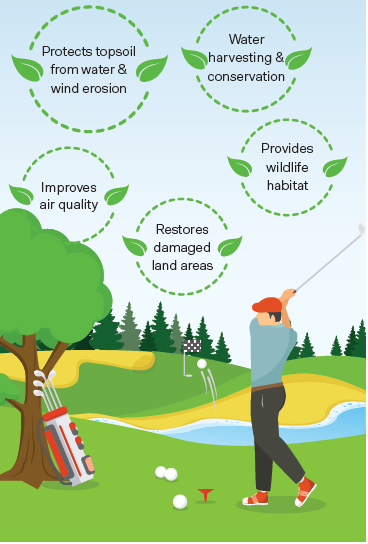NEW DELHI
As April 22 is observed as World Earth Day, an article on golf and ecology is appropriate. Many environmentalists dispute the fact that golf can benefit the environment. After all, golf courses consume millions of gallons of water and occupy hundreds of acres of land. They use chemical fertilisers and pesticides and require expensive operations and maintenance practices.

Today however golf courses are increasingly using treated sewage water and use automatic irrigation only in key play areas. Organic fertilisers and sustainable maintenance practices are reducing contamination.
Golf courses add value to the neighbourhood because they are picturesque and provide habitat for various land and aquatic animals besides being able to recharge ground water and filtering stormwater runoff. The turf also protects topsoil from wind erosion.
Legendary player turned course designer Greg Norman says “Golf courses can be community assets. Not only can they elevate property values, create jobs and provide tax revenues, but they can also provide green spaces, filter air, purify water and create wildlife habitat.”
Five ways in which golf courses can benefit the environment
When golf courses are carefully designed and maintained, they actually have a significant positive impact on the environment.To commemorate Earth Day, we look at five ways in which golf courses benefit their surroundings:
1) Green lungs
The most obvious benefit of golf courses is that they serve as green lungs, especially in crowded and polluted cities such as Delhi and Mumbai. Golf courses also act as coolers, lowering overall air temperatures in the area.
2) Carbon sinks
Golf courses act as carbon sinks, absorbing carbon dioxide from the atmosphere and helping to reduce global warming. Studies have shown that about 55 sq ft of properly maintained turf also produces enough oxygen for one person for one day.
3) Wildlife habitat
When natural areas are left untouched, golf courses can double up as mini-nature reserves, providing a safe habitat for birds and other animals. A 2008 paper titled Wildlife Scores on Golf Courses, states that University of Arizona researcher Mike Goode found more rattlesnakes on the Stone Canyon Golf Course in Tucson than on adjacent land. The snakes were also larger and reproduced more often. A couple of months ago I spotted a mongoose crossing the 16th tee at the Willingdon Sports Club in Mumbai, where sightings of snakes are common too. Peacocks are regulars at the Delhi Golf Club. In fact, according to the Guidelines for Maximizing Biodiversity on Golf Courses, “a well-managed golf course can provide more environmental benefits than a poorly managed nature reserve.”
4) Improving land and water quality
When built on degraded land, golf courses can improve the quality of the land and provide a space for native plants to grow. They reduce stormwater runoff and allow the groundwater table to recharge, especially during the monsoon. They act as a giant strainer too, stripping contaminants from the runoff.
5) Preventing soil erosion
According to the USGA, turf reduces soil erosion, with studies showing “that turf holds up to 20 times more soil than traditionally-farmed cropland”.


